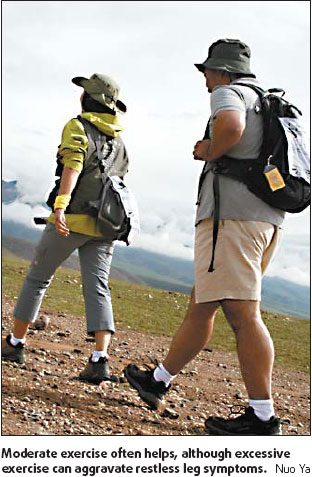Have fidgety, restless legs in bed? It's all in your genes

HAMBURG: Millions of people can't sleep at night because their legs tingle and itch in bed, forcing them to get up and walk around until they are utterly exhausted.
It's called Restless Legs Syndrome (RLS) and doctors have never been able to explain its cause - until now.
Researchers in Germany have discovered a genetic clue to the origins of RLS which might one day provide an effective therapy.
Scientists from the Munich GSF Research Centre for Environment and Health, the Technical University of Munich and the Max Planck Institute for Psychiatry have finally identified sequence variants in the human genome which are more frequent in RLS patients than in the normal population.
For the first time ever this allows insights into the underlying cause of this mystery-shrouded syndrome.
Surprisingly enough, the RLS genes discovered are known as control factors of early embryonic development. This discovery opens up completely new approaches to the further research into the causes and the development of innovative therapies.
The patients suffer from an urge to move the legs in the evening and during the night but only when they are lying in bed. The fidgety sensation can only be relieved by getting out of bed and walking around.
The consequence may be severe sleeping disorders, chronic sleep loss and associated daytime fatigue. In severe cases the disease may lead to depression and social isolation.
The frequency of RLS increases with age: Up to 10 percent of over 65-year-old are affected, albeit in very different forms. Children can, however, also contract the disease.
The cause of RLS was hitherto completely unknown. More than half of all RLS patients report about other family members who are also affected so that a genetic component was assumed to be involved in the development of the disease at an early stage.
Various groups of scientists have been looking for the genes which might play a role in RLS for years.
Heading a team of scientists from the Institute of Human Genetics of the GSF Research Centre, the Technical University of Munich and the Max Planck Institute for Psychiatry, Juliane Winkelmann and Professor Thomas Meitinger employed DNA chips which make it possible to determine 500,000 of the most common variants of the human genome.
The distribution of the variants between 400 RLS patients and 1,600 test subjects from the normal population was measured. This genome-wide comparison of frequent variants - also referred to as genome-wide association study - is one of the highlights of genome research this year. Groups of scientists from Germany, Austria and Canada were involved.
In all more than 1,500 RLS patients and 2,500 test subjects from the KORA Study of the GSF, which is conducted by Professor Erich Wichmann, participated in the study.
The function of the identified genes MEIS1, BTBD9 and LBXCOR1 surprised everybody involved because they are genes which are known in connection with the embryonic development of an organism.
During this activity phase they are involved in the pattern formation of the extremities and the central nervous system. The role of these genes in adults will now have to be examined in greater detail.
How soon the knowledge about the genetic risk factors can be implemented in innovative new therapeutic concepts, remains to be seen.
In any case new ways have now been opened up for the elucidation of the whole range of genetic and non-genetic causes of this disease. This offers researchers completely new perspectives for gaining an understanding of the cell-biology involved in the development of RLS.
DPA
(China Daily 08/22/2007 page19)














